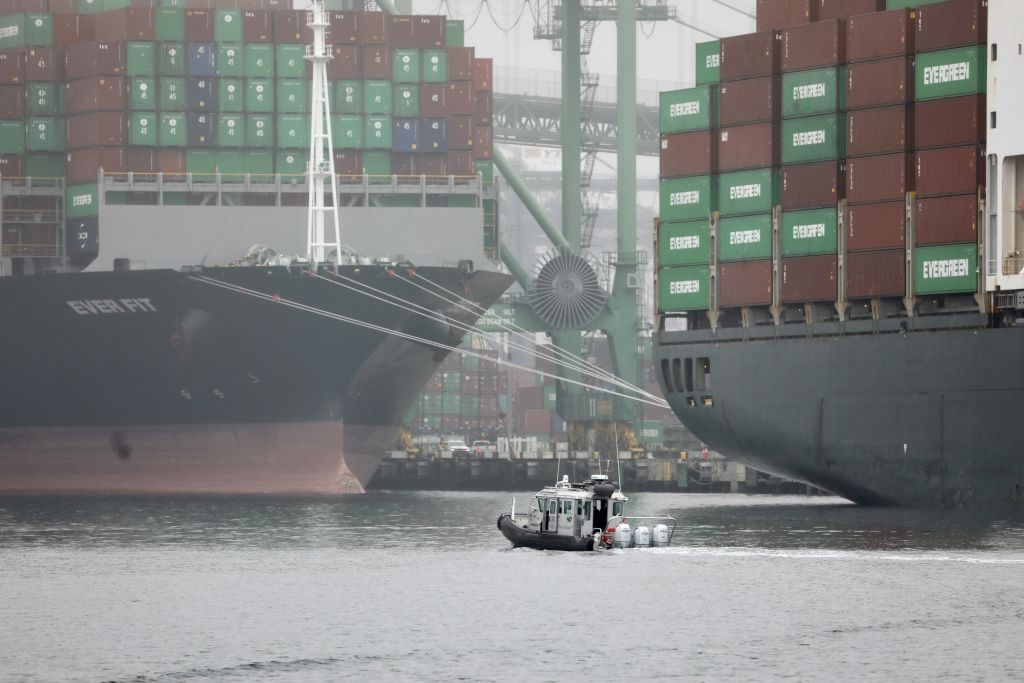Our supply chains reveal the spiritual desolation at the heart of America.
Slow Boat from China

What happens when the weakest link in the chain is you?
To some in the Biden Administration, the supply chain crisis can be dismissed as a loss of East Asian-made consumer trinkets that, as Vox tells us, we could all be better off without—or as White House spokesperson Jen Psaki suggested, amounts to little more than “the tragedy of the delayed treadmill.” Yet, in reality, a broken supply chain is hardly a rich man’s problem—global bankers are having their best year ever—but mostly impacts ordinary folks suffering from rising prices for everything from soybeans to natural gas. The crisis is now expected to last for at least a year.
The chaos on the ground level may not much hurt the elites of Manhattan or Palo Alto, but inflation, which is now expected to continue apace for at least the next year, has wiped out wage gains in the U.S., the UK, and Germany. Low-income groups are the most threatened, struggling to pay energy costs, surging rents, and higher food prices. All this is also eroding President Biden’s already weak poll numbers.
Our vulnerability to supply chain disruption clearly predates the Biden Administration, forged by the abandonment of the production economy over the past 50 years by American business and government, encouraged and applauded by the clerisy of business consultants. The result has been massive trade deficits that now extend to high-tech products, and even components for military goods, many of which are now produced in China. When companies move production abroad, they often follow up by shifting research and development as well. All we are left with is advertising the products, and ringing up the sales, assuming they arrive.
Unable to stock shelves, procure parts, power your home, or even protect your own country without waiting for your ship to come in, Americans are now unusually vulnerable to shipping rates shooting up to ten times higher than before the pandemic. Not surprisingly, pessimism about America’s direction, after a brief improvement Biden’s election, has risen by 20 points. The shipping crisis is now projected to last through 2023.
Not everyone loses here. For years the American establishment saw China as more of an opportunity than a danger. High-tech firms, entertainment companies, and investment banks profit, or hope to, from our dependency, becoming in essence the new “China lobby.” Behind the scenes these representatives of enlightened capital often work to prevent condemnation for the Middle Kingdom’s mercantilist policy, and its joint repression of democracy and ethnic minorities.
After all, the pain is not felt in elite coastal enclaves, but in Youngstown, south Los Angeles, and myriad other decaying locales. Meanwhile, by enabling China’s focus on production, and the conquest of technologies related to making goods, we have devastated large parts of our country. This shift has cost us 3.7 million jobs since 2000. Throughout the period between 2004 and 2017, the U.S. share of world manufacturing shrank from 15 to 10 percent, while our reliance on Chinese inputs doubled, even as our dependence on Japan and Germany shrank.
Yet perhaps even more debilitating has been our drift towards what British historian Martin Weiner has called “psychological de-industrialization.” Weiner was referring to the lack of interest in productive enterprise during late Victorian and Edwardian England, but he could just as easily be describing contemporary America’s corporate and financial elite.
Fortunately, America is not England, now a shadow of itself as an industrial country, living off its imperial connections to bolster its media, finance, and tourism sectors. It is a small country, at the edge of a fading continent in seemingly permanent decline. It lacks our vast expanse with its agricultural, energy, and other resources, not to mention our still considerable entrepreneurial spirit. As a huge continental country with enormous resources, lots of arable land and a large, traditionally hard-working population, the United States should be ideally suited to survive the retreat of the global economy, so evident in the supply chain crisis, and be able to shift to a more autarchic model.
These blessings have bailed us out before—evidenced by our remarkable transformation during the Second World War, the Cold War, and in response to Japan’s industrial juggernaut late in the last century. In the end, America remains a land with enormous sokojikara, or “reserve power,” as Japan political scientist Fuji Kamiya described it decades ago, that allows it to respond and overcome competitors.
But even possessing the best piece of real estate on the planet is not enough if you don’t take advantage of it. America’s brief flirtation with energy self-sufficiency is now being undermined both by increased imports from the Middle East and a drive to wipe out much of our domestic production. The passionate embrace of renewable energy bolsters China’s dominance of solar panels and the essential metals needed to produce “clean” electricity and electric cars.
There are scattered hopeful signs of an awakening national consciousness about where we are heading. China’s decision to block exports of medical goods led to widespread shortages, observes Richard Haass, President of the Council on Foreign Relations, raising fears that “an increasingly assertive China might seek to exploit the world’s dependence on it for political purposes.”
Some businesses are catching the drift. McKinsey and Company surveyed supply chain executives last year and found that nearly all respondents agree that their supply chains are too vulnerable. According to March 2020’s Thomas Industrial Survey, COVID-19 supply chain disruptions accelerated the search for locally-sourced materials and services. Up to 70 percent of firms surveyed said they were “likely” or “extremely likely” to re-shore in the coming years.
The exodus from China also includes Asian and other foreign firms. UBS projects20 to 30 percent of all Chinese capacity moving, which on $2.5 trillion of Chinese exports would imply $500 billion to $750 billion shifting elsewhere, notably to the big market of North America. Last year, Taiwan Semiconductor Manufacturing, the world’s leading chip foundry, decided to build a $12 billion new plant in Arizona, and Samsung, a huge Korean chipmaker, is also shopping in the United States for a $17 billion plant. This would remove one of the most devastating causes of supply chain problems, which has dramatically slowed auto production.
Some major American companies, including Black and Decker, Whirlpool, General Electric, Apple, Caterpillar, Goodyear, General Motors, Little Tykes, and Polaris have begun to reshore some production. They are not alone. In 2019, for the first time in a decade, the percentage of United States manufacturing goods that were imported dropped, notes a recent Kearny study, with much of the shift coming from east Asia.
Overall, the annual rate of jobs coming from offshore, according to the Reshoring Initiative, has grown from 6,000 in 2010 to over 400,000 in 2019. This is a good beginning, but still barely 5 percent of total U.S. industrial employment. Much of big capital, notably Wall Street, remains a bastion of pro-China sentiment. Investment management giant BlackRock likes to advertise its environmental and social justice agenda here at home, but happily launched new initiatives to make billions made off our co-dependency with China. Neither Silicon Valley nor the financial moguls seem ready to give up a profitable relationship with an oppressive regime powered largely by the very fossil fuels that they want to wipe out here.
Under normal circumstances, we would expect a government more focused on reshoring and addressing the supply chain than indulging in virtue signaling on everything from climate to race and gender. Nor is this the time to look towards libertarian-oriented conservatives who religiously cling to their free market dogma even in dealing with a highly nationalistic, Communist competitor which dictates by law that every enterprise must subordinate itself to the needs of state and party.
Trump, to his credit, at least understood the challenge posed by our lack of competitive strength. But his bombastic tone and his inability to communicate with people outside the White House—and potential allies—weakened his ability to craft an adequate response. Fortunately, the Biden administration has continued to pursue many of Trump’s themes, with proposals to boost the semiconductor and steel industries and spend $300 billion on R&D to revitalize American industrial competitiveness and invest in trade schools, apprenticeships, and community colleges as alternatives to four-year colleges.
A more ambitious part of the plan involves the use of taxes, subsidies, and public-private partnerships to encourage companies to retain the capacity to make critical supplies during a national emergency.Yet the Biden Administration seems unfocused on such critical issues as trade and supply chains, with a greater emphasis on optics than results. They hold a conference of electric cars but exclude Tesla, the world’s cutting edge company in the field, largely because they are not unionized. Yet the pro-labor mantra falls down when you consider that the Administration’s first action was to kill off 10,000 mostly union jobs associated with the Keystone Pipeline offering only the chimera of far less lucrative, and usually non-union, “green jobs.”
One test may be how the administration deals with the fact that China is again inundating the market for masks, which they dominated totally before the pandemic. Concentrated in the heartland, American entrepreneurs who rose to fill the gap have some protection in their contracts with federal agencies. But private hospitals seem willing to re-embrace their dependency for a few pennies. Libertarians, investment bankers, and China’s American allies may cheer, but thousands of jobs are already being lost.
Sadly, even as the economy lurches towards stagnation, the Biden Administration seems to listen more closely to its urban-centric, coastal green supporters than to the needs of the workers critical to keeping the country moving. On some fronts Biden’s tax, regulatory, climate, and labor law agenda undermine the intent of bringing production back home by making it ever more expensive to produce here.
For the foreseeable future, the best solutions will likely come not from Washington, but production oriented regions like Ohio, Kentucky, and Tennessee, now sensibly focusing on skills training and trying to accommodate industrial expansion. These areas, and much of the South and Southwest, have become the new focal point for U.S. industry.
It’s better for a region, and the national economy, to train machinists and welders than forge new acolytes of Critical Race Theory. It would be better to make the activities of the people who drive our trucks, run the lathes, drill for oil, or package our food more productive and less polluting rather than feather the nests of our financial, tech, and corporate oligarchs. The green social justice utopia driving the current progressive push will likely inhabit only a distant future, and by the time we get there, it will already be China’s world—not ours.
The American Mind presents a range of perspectives. Views are writers’ own and do not necessarily represent those of The Claremont Institute.
The American Mind is a publication of the Claremont Institute, a non-profit 501(c)(3) organization, dedicated to restoring the principles of the American Founding to their rightful, preeminent authority in our national life. Interested in supporting our work? Gifts to the Claremont Institute are tax-deductible.

